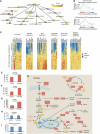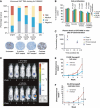The androgen receptor fuels prostate cancer by regulating central metabolism and biosynthesis
- PMID: 21602788
- PMCID: PMC3155295
- DOI: 10.1038/emboj.2011.158
The androgen receptor fuels prostate cancer by regulating central metabolism and biosynthesis
Abstract
The androgen receptor (AR) is a key regulator of prostate growth and the principal drug target for the treatment of prostate cancer. Previous studies have mapped AR targets and identified some candidates which may contribute to cancer progression, but did not characterize AR biology in an integrated manner. In this study, we took an interdisciplinary approach, integrating detailed genomic studies with metabolomic profiling and identify an anabolic transcriptional network involving AR as the core regulator. Restricting flux through anabolic pathways is an attractive approach to deprive tumours of the building blocks needed to sustain tumour growth. Therefore, we searched for targets of the AR that may contribute to these anabolic processes and could be amenable to therapeutic intervention by virtue of differential expression in prostate tumours. This highlighted calcium/calmodulin-dependent protein kinase kinase 2, which we show is overexpressed in prostate cancer and regulates cancer cell growth via its unexpected role as a hormone-dependent modulator of anabolic metabolism. In conclusion, it is possible to progress from transcriptional studies to a promising therapeutic target by taking an unbiased interdisciplinary approach.
Conflict of interest statement
The authors declare that they have no conflict of interest.
Figures






Comment in
-
From DNA binding to metabolic control: integration of -omics data reveals drug targets for prostate cancer.EMBO J. 2011 Jul 6;30(13):2516-7. doi: 10.1038/emboj.2011.205. EMBO J. 2011. PMID: 21731047 Free PMC article.
Similar articles
-
Y-box binding protein-1 promotes castration-resistant prostate cancer growth via androgen receptor expression.Endocr Relat Cancer. 2011 Jul 11;18(4):505-17. doi: 10.1530/ERC-11-0017. Print 2011 Aug. Endocr Relat Cancer. 2011. PMID: 21652770
-
Expression of GnRH type II is regulated by the androgen receptor in prostate cancer.Endocr Relat Cancer. 2007 Sep;14(3):613-24. doi: 10.1677/ERC-07-0041. Endocr Relat Cancer. 2007. PMID: 17914092
-
Interplay of nuclear factor-kappaB and B-myb in the negative regulation of androgen receptor expression by tumor necrosis factor alpha.Mol Endocrinol. 2008 Feb;22(2):273-86. doi: 10.1210/me.2007-0332. Epub 2007 Nov 1. Mol Endocrinol. 2008. PMID: 17975021 Free PMC article.
-
Oxidative stress and androgen receptor signaling in the development and progression of castration-resistant prostate cancer.Free Radic Biol Med. 2011 Oct 1;51(7):1320-8. doi: 10.1016/j.freeradbiomed.2011.07.011. Epub 2011 Jul 23. Free Radic Biol Med. 2011. PMID: 21820046 Review.
-
Androgen action in the prostate gland.Minerva Urol Nefrol. 2012 Mar;64(1):35-49. Minerva Urol Nefrol. 2012. PMID: 22402316 Review.
Cited by
-
Targeting chromatin binding regulation of constitutively active AR variants to overcome prostate cancer resistance to endocrine-based therapies.Nucleic Acids Res. 2015 Jul 13;43(12):5880-97. doi: 10.1093/nar/gkv262. Epub 2015 Apr 23. Nucleic Acids Res. 2015. PMID: 25908785 Free PMC article.
-
Alanine-Serine-Cysteine Transporter 2 Inhibition Suppresses Prostate Cancer Cell Growth In Vitro.J Clin Med. 2022 Sep 16;11(18):5466. doi: 10.3390/jcm11185466. J Clin Med. 2022. PMID: 36143113 Free PMC article.
-
N-linked glycosylation supports cross-talk between receptor tyrosine kinases and androgen receptor.PLoS One. 2013 May 28;8(5):e65016. doi: 10.1371/journal.pone.0065016. Print 2013. PLoS One. 2013. PMID: 23724116 Free PMC article.
-
The double-edged sword of AMPK signaling in cancer and its therapeutic implications.Arch Pharm Res. 2015 Mar;38(3):346-57. doi: 10.1007/s12272-015-0549-z. Epub 2015 Jan 10. Arch Pharm Res. 2015. PMID: 25575627 Free PMC article. Review.
-
STAMP2 Expression Mediated by Cytokines Attenuates Their Growth-Limiting Effects in Prostate Cancer Cells.Cancers (Basel). 2021 Mar 30;13(7):1579. doi: 10.3390/cancers13071579. Cancers (Basel). 2021. PMID: 33808059 Free PMC article.
References
-
- Anderson KA, Ribar TJ, Lin F, Noeldner PK, Green MF, Muehlbauer MJ, Witters LA, Kemp BE, Means AR (2008) Hypothalamic CaMKK2 contributes to the regulation of energy balance. Cell Metab 7: 377–388 - PubMed
-
- Attar RM, Jure-Kunkel M, Balog A, Cvijic ME, Dell-John J, Rizzo CA, Schweizer L, Spires TE, Platero JS, Obermeier M, Shan W, Salvati ME, Foster WR, Dinchuk J, Chen SJ, Vite G, Kramer R, Gottardis MM (2009) Discovery of BMS-641988, a novel and potent inhibitor of androgen receptor signaling for the treatment of prostate cancer. Cancer Res 69: 6522–6530 - PubMed
-
- Attard G, Reid AH, A'Hern R, Parker C, Oommen NB, Folkerd E, Messiou C, Molife LR, Maier G, Thompson E, Olmos D, Sinha R, Lee G, Dowsett M, Kaye SB, Dearnaley D, Kheoh T, Molina A, de Bono JS (2009) Selective inhibition of CYP17 with abiraterone acetate is highly active in the treatment of castration-resistant prostate cancer. J Clin Oncol 27: 3742–3748 - PMC - PubMed
-
- Bailey TL, Elkan C (1995) The value of prior knowledge in discovering motifs with MEME. Proc Int Conf Intell Syst Mol Biol 3: 21–29 - PubMed
-
- Barski A, Cuddapah S, Cui K, Roh TY, Schones DE, Wang Z, Wei G, Chepelev I, Zhao K (2007) High-resolution profiling of histone methylations in the human genome. Cell 129: 823–837 - PubMed
Publication types
MeSH terms
Substances
Associated data
- Actions
- Actions
Grants and funding
LinkOut - more resources
Full Text Sources
Other Literature Sources
Medical
Molecular Biology Databases
Research Materials

